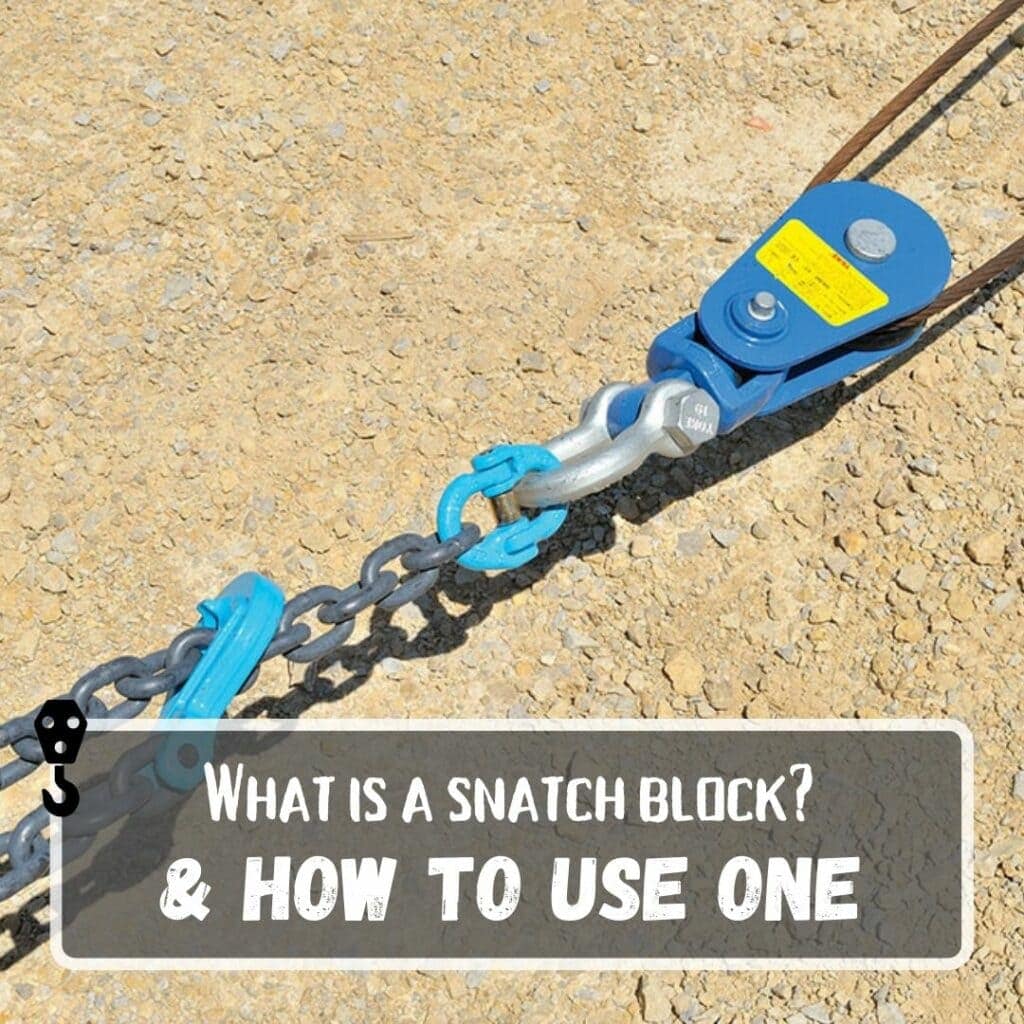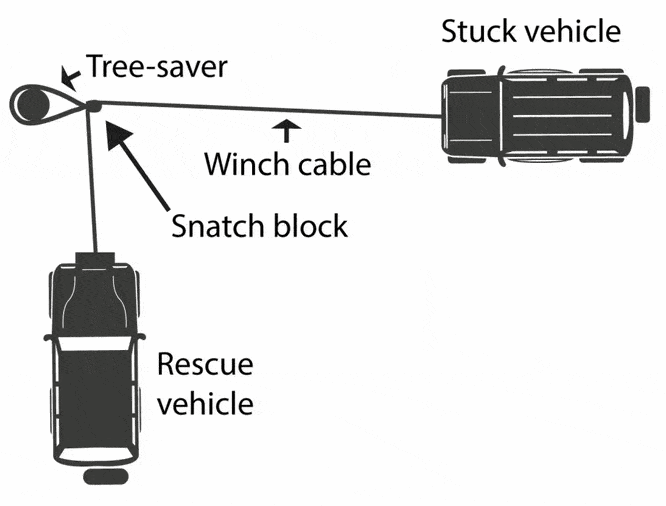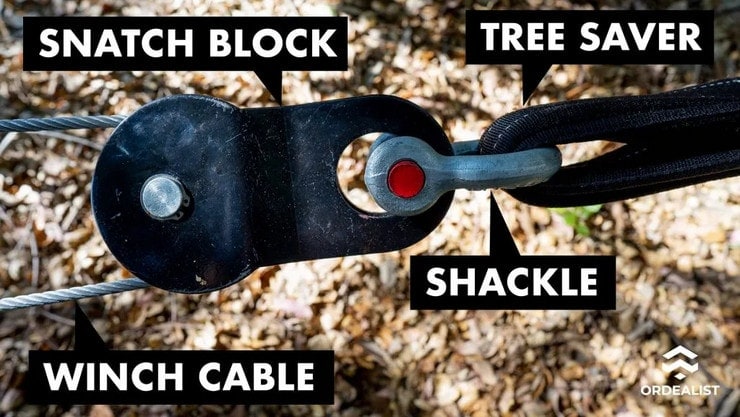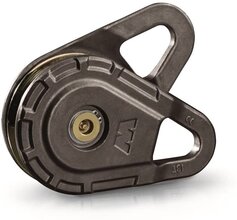If you are into ATVs, trucks, or general off-roading, then you might have heard about a snatch block, also known as a winch block.
These tools are essential for overlanding, off-roading, and winching out heavy vehicles or vehicles in awkward spots.
If you have no idea what a snatch block is or how it works, this article is for you. Read on.

What Is a Snatch Block?
A snatch block is simply a pulley that attaches to a sturdy anchor point that can be mounted easily and quickly.
In the automotive world, snatch blocks usually work together with winches.
The line running through the snatch block’s pulley connects to the vehicle’s winch, enhancing the flexibility in how you use the winch and opening up numerous other possibilities for self or partnered recovery.
A snatch block can also enhance your winch’s pulling capacity. That means it can come in handy when you need more force to pull a larger vehicle than yours. Three major types of snatch blocks include:
- Snatch block with hook attachment – often used with winches and wire rope hoists in temporary applications.
- Snatch block with shackle – Used in temporary and permanent rigging applications.
- Swing block – Often used with vehicle winches and 4×4 off-roaders.
It is worth noting that snatch blocks have a maximum weight capacity. Before using a snatch block, make sure it can handle the weight you want it to pull. People often make the mistake of not equipping their winch with a line rated above its pulling capacity.
As a result, they double the force exerted on the winch line, and this can be potentially dangerous. Always winch using a line dampener because a broken line or snatch block can not only cause injuries to you and damage to your rig, but it can also leave you stranded in the bush.
Ready to buy a snatch block? Click here to see the best prices on Amazon.
How to Use a Snatch Block
Snatch blocks are versatile tools, and you can use them in various situations and configurations in off-road recovery. Their two primary purposes in off-road recovery are:
- Increasing a winch’s pulling force
- Redirecting the winch cable’s force to pull the stuck vehicle from various angles
It’s worth noting that snatch blocks derive their name because they literally snatch some of the force that is usually entirely handled by the winch.
Snatch blocks can also relieve winches of some stress and heat buildup. Let’s explore a few common techniques of using a snatch block.
Using a Snatch Block to Increase Winch Pulling Force

A snatch block provides a mechanical advantage to enhance the winch pulling force. You achieve this by passing the winch cable around the snatch block’s pulley and back to the vehicle. In this way, you can almost double the winch pulling force in a self-recovery situation when using a tree as an anchor.
This technique involves the winch cable extending from the winch on your vehicle through a snatch block and back to the solid recovery point on the vehicle. The snatch block will reduce the pulling force that the winch requires, and the tree serving as the anchor will bear the vehicle’s entire load.
Many off-road enthusiasts prefer this winch-and-snatch-block recovery technique. While you have the option of anchoring directly to the tree saver with recovery shackles instead of a snatch block, using the snatch block helps to reduce the stress on your winch.
Instead of using a tree as an anchor in recovering your stuck vehicle, you can also use another vehicle’s winch. In this case, you will need to connect the snatch block to your vehicle with a shackle at a solid recovery point. Then, the winch cable will run from the recovery vehicle through the stuck vehicle’s shackle and connect back to the recovery vehicle with the shackle at the recovery point.
You can use multiple snatch blocks to boost the winch’s pulling power further. You can achieve this by attaching a second snatch block to the recovery vehicle, passing the cable through it and back to your stuck vehicle. This technique will almost triple the winch’s pulling force, and it can come in handy when the vehicle’s weight is much more than the winch’s capacity or when you need additional force to pull an extremely stuck vehicle loose.
Using a Snatch Block to Redirect the Winch Cable

A snatch block is also effective in redirecting the winch cable. At times, pulling a stuck vehicle directly using a recovery vehicle’s winch can be challenging. If you find yourself in such a situation, you can use a snatch block to redirect the recovery vehicle’s pulling force so it can pull the stuck vehicle in the correct direction.
You will need to use a tree as an anchor, allowing the recovery vehicle to exert its pulling force on the stuck vehicle at an angle of 90 degrees. You will attach the snatch block to a tree saver trap using a shackle to avoid damaging the tree. If you can’t find a strong tree, a secure boulder or any other large object could serve as an alternative.
It’s worth noting that there’s no mechanical advantage in this situation as the snatch block doesn’t reduce the power that the winch requires to pull the stuck vehicle.
How to Connect a Snatch Block to a Tree Saver Strap

We’ve already mentioned the importance of using a tree saver to attach your winch cable to a tree or boulder – it protects the tree, your anchor, and winch cable from damage. If you use a snatch block to boost the winch’s pulling force or redirect the winch cable, use a shackle to attach the snatch block to the tree saver.
Before you connect the winch line to the shackle, thread it around the sheave of your snatch block. Be sure to always use a rated shackle, with the manufacturer’s working load limit (WLL) clearly indicated.
Metal shackles usually have their WLL inscribed on the side. If you opt for a synthetic shackle, ensure you know its load limit. Avoid sideloading your D-ring shackle as it will weaken it. Additionally, your shackle should always have its pin fully screwed.
How Is a Snatch Block Different from a Pulley?
Pulleys and snatch blocks are both pulley blocks designed to help you facilitate your lifting operations. They both feature a wheel on an axle that enables you to lift heavy objects up to 30 tons. You can easily substitute a pulley block for winch snatch blocks and attain the same level of efficiency.
A pulley block helps direct the kinetic rope while loaded and can increase the line pull or lifting capacity of a winch or hoist by multiplying the number of lines. The main difference between a pulley block and a snatch block is that a pulley block remains closed and requires you to thread the line through the axle, whereas the snatch block opens with a gate on the side, allowing for easy lifting on the wire rope.
Conclusion
Snatch blocks are an integral component of your off-road vehicle recovery kit, and it is a must-buy if your ATV, SUV, or truck comes with a winch. However, they can be dangerous if used incorrectly, so it’s critical to learn how to use pulleys with a winch before you can use a snatch block.
Ready to buy a snatch block? Click here to read our review of the best snatch blocks available now.
